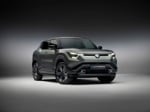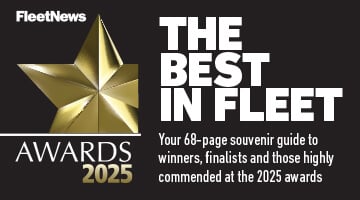The new model was premiered at the Amsterdam Van Show on October 16 and after a press launch in Nice last week, officially went on sale on November 3.
At the launch, Renault chiefs were keen to point out that the new Master was designed, developed and built by the French manufacturer. But it will also be rebadged as a Vauxhall Movano and Nissan Interstar, so will in fact form the basis of a fair percentage of the total market.
Prices range from £13,940 to £22,040 ex-VAT.
Most noticeable feature of the new van is its front end, which brings it more into line with other Renault vans, the Kangoo and Trafic. The three now have a family face which should be instantly recognised, especially as all have a large Renault diamond emblazoned on their grilles.
New Master also has masses of protective plastic all round. Front and rear bumpers are both huge and side rubbing strips are augmented by plastic wheel arch protectors. Inside, the cab has been redesigned to create a complete mobile working environment, according to Renault.
The dashboard now looks more like that of the smaller Trafic and the gearstick moves from floor to dash.
The driver's seat now features an armrest and adjusts for height, reach and rake, although the steering column does not adjust.
A CD player comes as standard along with a driver's airbag (a paid-for option on the old model), alarm and remote central locking.
New Master also has a multitude of storage spaces, including two-litre cola bottle bins in each door, coffee cup holders on both sides, A4 paper sheaf holder and a handy document clip.
Another option is a special double passenger seat which folds down to reveal storage for computers and other office equipment.
Other options include air conditioning with heated front screen at £700, passenger airbag at £220, satnav at £1,250 and a rear parking sensor at £100, which is half the price of versions from Ford and Peugeot. A bulkhead is standard but can be deleted at no cost.
In the business end, gross vehicle weights range from 2.8 to 3.5 tonnes and there are three wheelbases and roof heights. Payloads range from 1,001kg to 1,652kg and load volumes from eight cubic metres to 13.6 cubic metres.
The old 2.2-litre common rail diesel engine has been dropped from the range, to be replaced by a new 2.5-litre unit, which joins the old 1.9-litre and a Nissan-sourced 3.0-litre unit. Power ranges from 82bhp to 136bhp and torque from 147 lb-ft to 235lb-ft. Lower-powered models have a five-speed gearbox while higher-powered versions get a six-speed box.
On the safety front, ABS brakes are standard, along with electronic brake distribution and electronic brake assist. Renault tested the van against opposition models and claims stopping distances are best in class.
In addition to the panel vans, there will also be a host of conversions on offer with chassis cabs, double cabs and platform cabs.
Behind the wheel
SIPPING a cappuccino in a cafe on the waterfront at St Tropez on a sunny afternoon last week, I reflected that there were worse jobs in the world than being a van journalist.
I had just driven for two hours from Nice, along the A8 autoroute and through the twisty, hilly country roads around Grimaud, to reach the hallowed playground of the rich and as I drained my coffee to prepare for the return journey, I realised that life was unlikely to get any better than this.
One thing is certain – I had no twinges in my back. The driver's seat of the Master is arguably the best in class and leaves no ill effects after a long drive. It hugs the back right up to the shoulder blades and there is plenty of depth in the seat squab to support the thighs. The steering wheel doesn't adjust for height but if my 6ft 3in frame fits in snugly, anyone else's should too.
My first drive was in the top-of-the range 3.0-litre Master in medium wheelbase, medium-roof format. It was maybe an unfair test as Renault believes only 5-10% of buyers will opt for this behemoth. It certainly lets you know when it wakes up in the morning with the engine emitting a meaty growl and the driving experience is consequently very truck-like.
Such is the pulling power of the Nissan unit that even with 1,200kg of sand in the back, it was very much a case of pick a gear, any gear – and there are six to choose from in the higher-powered models.
For the return journey, I chose the 2.5-litre short wheelbase version loaded with 800kg and found it quieter, smoother and all-round a more enjoyable drive. For fleet purposes, this is definitely the one to choose. With the 100bhp unit at £15,790, why opt for the 115bhp unit at £16,990? After all, £1,200 is a lot to pay for a few extra horses and an extra gear cog.
Our test day started at Nice airport, where the collected journalists were able to look round the vehicles for the first time. Those protective plastic strips all round are bound to save the fleet operator a small fortune over the vehicle's life as vans are sure to be knocked and scraped during their working days. I'd recommend that good-value rear parking sensor as a must too, especially for health and safety reasons.
Climbing aboard, the cabin has come on in leaps and bounds over the old model. Apart from the aforementioned driver's seat, there are many more little touches that show that a great deal of thought has gone into the new van. OK, so the inclusion of coat hooks may not exactly be the latest rocket science, but how many other heavy panel vans have them? None as far as I can recall.
The can holders on each side of the van will double as mobile phone pockets and the storage spaces are all big enough to hold the items they are designed to hold. The only complaint was from one journalist among us who smoked – he reported that the ashtray was laughably small and held about two fag ends. The danger here is that the rest will end up all over the floor.
In the back, all is much as it was with the old Master, but no marks lost there. Rear doors open to 180 degrees but £300 will buy the 270 degree optional opening items. One extra safety aid is that with the doors open, the van's rear lights can still be seen by other vehicles down the road. Other extras I would mark down as absolutely necessary are a wooden floor and half-height side panels at £320. That money will be more than recouped at selling time when you remove said panels to reveal a pristine interior three or four years down the line. Secondhand buyers will be impressed and will willingly stump up extra cash. And so to the road...
The Master proved exactly what we expected – power steering is nicely weighted, the clutch is light and the van's almost horizontal steering wheel gives an ideal driving position. The van sailed through the twisty mountain road section and the brakes proved themselves twice when kamikaze French lorry drivers met us on the wrong side of the road on hilly corners.
Driving verdict
WITH the panel van sector going great guns this year, the combined might of this van with Renault, Vauxhall and Nissan badges is bound to sway fleet sales in its favour.
| Renault Master fact file | ||||||||||||
|---|---|---|---|---|---|---|---|---|---|---|---|---|
| Model | 1.9 | 2.5 | 2.5 | 3.0 | ||||||||
| Power (bhp/rpm): | 82/3,500 | 100/3,500 | 115/3,500 | 136/3,600 | ||||||||
| Torque (lb-ft/rpm): | 147/2,000 | 191/1,500 | 213/1,600 | 236/1,800 | ||||||||
| GVW (tonnes): | 2.8 | 2.8-3.5 | 2.8-3.5 | 3.5 | ||||||||
| Payload (kg): | 1,043 | 1,001-1,551 | 1,001-1,551 | 1,513-1,652 | ||||||||
| Prices (ex-VAT): | £13,940-£22,040 | |||||||||||
















Login to comment
Comments
No comments have been made yet.